Resident Crews of the Mir
![]()
Mir: Expedition 28 |
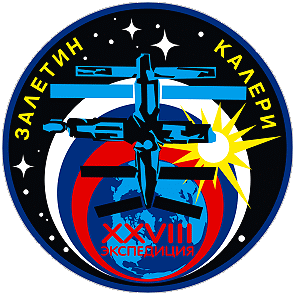 |
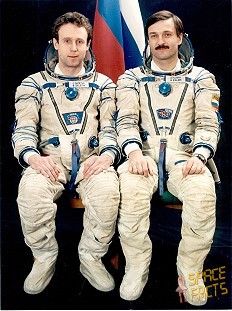 |
|
alternative crew photo |
![]()
Crew, launch- and landing data
| No. | Nation | Surname | Given names | Position | Spacecraft (launch) |
Launch date |
Launch time |
Spacecraft (landing) |
Landing date |
Landing time |
Mission duration |
Orbits |
| 1 | Zalyotin | Sergei Viktorovich | Commander | Soyuz TM-30 | 04.04.2000 | 05:01:28.923 UTC | Soyuz TM-30 | 16.06.2000 | 00:43:22 UTC | 72d 19h 41m 53s | 1145 | |
| 2 | Kaleri | Aleksandr Yuriyevich | Flight Engineer | Soyuz TM-30 | 04.04.2000 | 05:01:28.923 UTC | Soyuz TM-30 | 16.06.2000 | 00:43:22 UTC | 72d 19h 41m 53s | 1145 |
Backup Crew
| No. | Nation | Surname | Given names | Position |
| 1 | Sharipov | Salizhan Shakirovich | Commander | |
| 2 | Vinogradov | Pavel Vladimirovich | Flight Engineer |
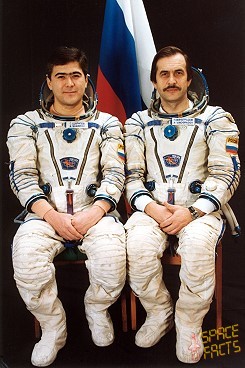 |
alternative crew photo |
Expedition Report
|
Launch from the Baikonur Cosmodrome and
landing 44 km southeast of Arkalyk. Soyuz TM-30 was launched from Baikonur with on board the crew for the 28th resident crew to the Mir space station. The crew consisted of Sergei Zalyotin (Commander), who was making his first spaceflight and Aleksandr Kaleri, Flight Engineer, who was entering orbit for the 3rd time. Following a two-day solo flight Soyuz TM-30 docked with the Mir space station on April 06, 2000. Sergei Zalyotin and Aleksandr Kaleri became the 28th and final resident crew. The last meters of the approach and the docking were executed in the manual mode. Just before reaching a distance of 9 meters the cosmonauts saw a deviation of 1 or 2 degrees along one of the axes. (Some press reports said that just before the docking the approach was again in the automatic mode, but a TsUP's spokesman denied this.) The crew of the mission was sent by MirCorp, a privately funded company, to reactivate and repair the station. The mission was part of an effort by MirCorp to refurbish and privatize the aging Mir space station, which was nearing the end of its operational life. Further commercially funded missions beyond Soyuz TM-30 were originally planned to continue the restoration efforts of the then 14-year-old space station, but insufficient funding and investment ultimately led to the de-orbit of the station in early 2001. Sergei Zalyotin and Aleksandr Kaleri reactivated the uninhabited station. The cosmonauts unloaded Progress M1-1, which resupplied the station. The Progress spacecraft was also used to raise the station's orbit to 360 x 378 km x 51.6 deg. They started air pressure checks using the mano vacuum-meter (MVM) from the BO (life compartment of the Soyuz TM-30) and agreed upon the use of the same MVM for all pressure measurements. Measurements during 07.04 gave valued between 625 and 619 MM Mercury. The accent was put on the work on the life support systems, like the replacement and installation of ventilators, the separation of a cooling loop to be able to purify this, work on the BKV, while on April 09. 2000 the Elektrons, the electrolysis oxygen generators, got the first attention. To make accurate pressure measurements in these parts of the complex possible, the SO (docking compartment at the Kristall module) and the Priroda were shielded off hermetically from other parts of the station. The crew had switched on one of the Elektrons, but this switched itself off. From the beginning the Mir-28 crew was very busy with air-seal checks in several compartments and modules. This search was intensified on April 18, 2000 and April 19, 2000. The crew worked with special equipment, which had been brought to the station together with the present crew. They spoke about an instrument called Bar and a thermo-hygrometer. The cosmonauts had to disconnect cables in the PKhO (the transition section) to make it possible to close the hatches through which these cables are deployed. The co-ordination with TsUP during these activities was very good and all went well during this risky work. Progress M1-1 separated from Mir on April 26, 2000 at 16:33 UTC for decay over the Pacific east of New Zealand at 19:27 UTC. Progress M1-1 was launched by from the Baikonur Cosmodrome at 06:47:23 UTC on February 01, 2000. The spacecraft docked with Mir, which was at that time unmanned, at 08:02:28 UTC on February 03, 2000 - the docking port used was the aft port on the Kvant1 module. Progress M1-2 was launched at 20:08:02 UTC on April 25, 2000. The new freighter Progress M1-2 docked with the space station on April 27, 2000. Approach and docking were executed with the help of the system Kurs. All went flawlessly and smoothly. The freighter docked at the aft docking port (Kvant2 +X axis) at 21:28:48 UTC. The equalization of the pressures between the station and the freighter lasted long this time. Aleksandr Kaleri said that the cargo bay of the Progress M1-2 was only half full. The air-seal was in good order, but there had been some variations in the air pressure, which in his opinion were caused by the differences in temperature. In 30 minutes, the pressure decreased by 4 MM mercury, and then the decrease stopped. At last the pressure inside the station was 687 MM. The crew still had to install the clamps between the Progress M1-2 and the Kvant1 docking port. These clamps make it impossible for the freighter to wander away. The only EVA in this mission was performed by both cosmonauts on May 12, 2000 (5h 03m). The 'germatizator-experiment', the use of a special glue to seal off cracks or damages at the outside surface of the complex, was executed according to plan. The following activity was the inspection of a malfunctioning solar battery on the Kvant1 (Module-E). Problem with this solar battery was that it was impossible to turn the panel into the most effective angle towards the sun. The cosmonauts found out that the steering cable to the rotor of the solar battery was burnt through during a short-circuit. The cosmonauts made images of the cable. The last activity was the so-called panorama-inspection, making images of the outside of the complex to enable specialist to analyze the effects of ageing of the material. The new freighter Progress M1-2 was also inserted in this inspection. The Soyuz spacecraft is composed of three elements attached end-to-end - the Orbital Module, the Descent Module and the Instrumentation/Propulsion Module. The crew occupied the central element, the Descent Module. The other two modules are jettisoned prior to re-entry. They burn up in the atmosphere, so only the Descent Module returned to Earth. Having shed two-thirds of its mass, the Soyuz reached Entry Interface - a point 400,000 feet (121.9 kilometers) above the Earth, where friction due to the thickening atmosphere began to heat its outer surfaces. With only 23 minutes left before it lands on the grassy plains of central Asia, attention in the module turned to slowing its rate of descent. Eight minutes later, the spacecraft was streaking through the sky at a rate of 755 feet (230 meters) per second. Before it touched down, its speed slowed to only 5 feet (1.5 meter) per second, and it lands at an even lower speed than that. Several onboard features ensure that the vehicle and crew land safely and in relative comfort. Four parachutes, deployed 15 minutes before landing, dramatically slowed the vehicle's rate of descent. Two pilot parachutes were the first to be released, and a drogue chute attached to the second one followed immediately after. The drogue, measuring 24 square meters (258 square feet) in area, slowed the rate of descent from 755 feet (230 meters) per second to 262 feet (80 meters) per second. The main parachute was the last to emerge. It is the largest chute, with a surface area of 10,764 square feet (1,000 square meters). Its harnesses shifted the vehicle's attitude to a 30-degree angle relative to the ground, dissipating heat, and then shifted it again to a straight vertical descent prior to landing. The main chute slowed the Soyuz to a descent rate of only 24 feet (7.3 meters) per second, which is still too fast for a comfortable landing. One second before touchdown, two sets of three small engines on the bottom of the vehicle fired, slowing the vehicle to soften the landing. The descent module of the Soyuz TM-30 with on board the crew of Mir-28, consisting of Sergei Zalyotin and Aleksandr Kaleri, made a safe landing 44 kilometers south east of Arkalyk in Kazakhstan on June 16, 2000 at 00:43:22 UTC. |
EVA data
| Name | Start | End | Duration | Mission | Airlock | Suit | |
| EVA | Kaleri, Aleksandr | 12.05.2000, 10:44 UTC | 12.05.2000, 15:47 UTC | 5h 03m | Soyuz TM-30 | Mir - Kvant2 | Orlan-M No. 6 |
| EVA | Zalyotin, Sergei | 12.05.2000, 10:44 UTC | 12.05.2000, 15:47 UTC | 5h 03m | Soyuz TM-30 | Mir - Kvant2 | Orlan-M No. 4 |
Photos / Graphics
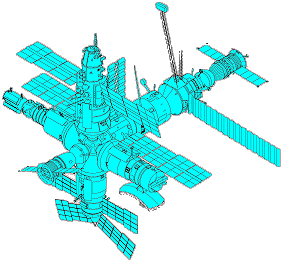 |
 |
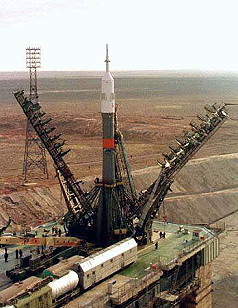 |
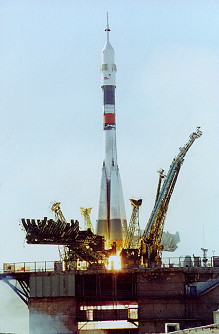 |
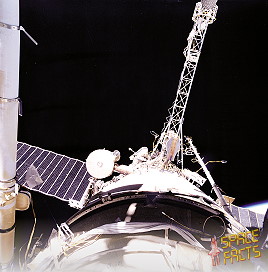 |
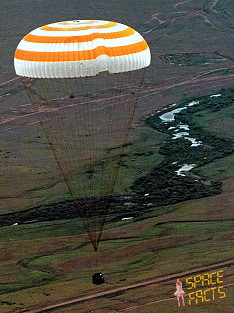 |
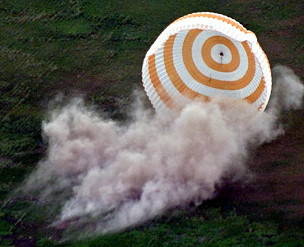 |
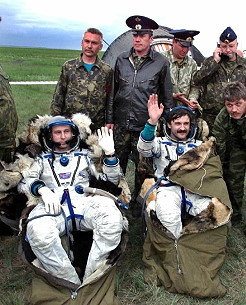 |
| © |  |
Last update on September 04, 2021.  |
 |